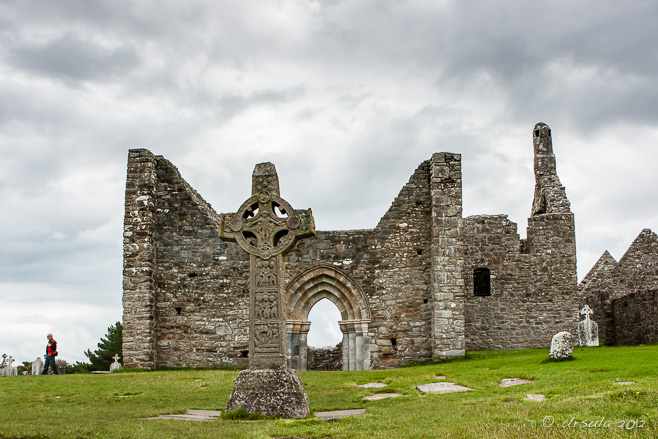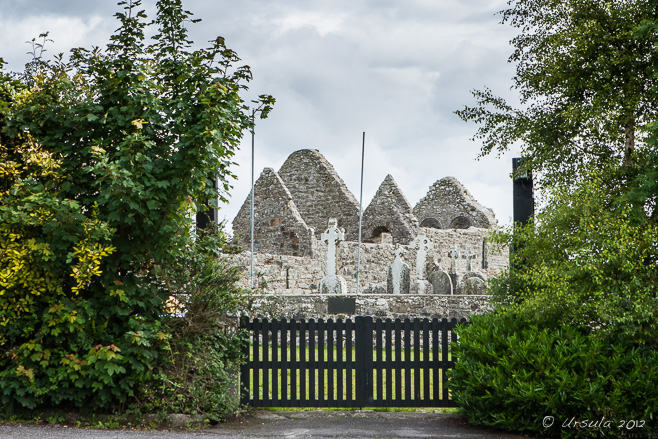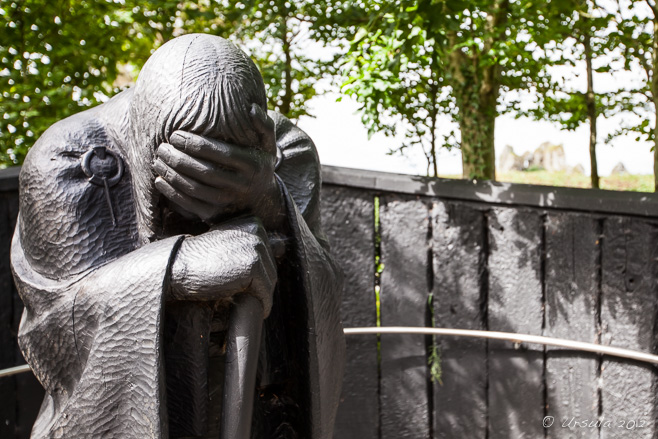
Clonmacnoise Cathedral
A replica of the West High Cross, the ‘Cross of the Scriptures’, depicting scenes from the crucifixion of Jesus, sits in front of the ruins of the cathedral, originally built in 909 AD.
Religion and religious faith are the heart of Ireland.
So, it seems fitting that one of the most fascinating religious/historical sites sits at the heart of the country – almost dead centre – where the traditional east-west land route crossed the River Shannon. It is also apposite that this site, dating back to the earliest days of Christianity, is still used as a place of worship today.
Cluain Mhic Nois (“Meadow of the sons of Nos”) or Clonmacnoise was founded by Saint Ciarán of Clonmacnoise (sometimes known as Ciarán the Younger, Ceran, Kieran or Queran), one of the Twelve Apostles of Ireland, as a monastery around 543-548. The actual dates vary with the source, but what is constant in the telling, is that Ciarán, who was in his early thirties, died of plague very shortly thereafter.
The monastery, however, lived on. Oenna, one of the men Ciarán converted at the first church he built at Inis Aingin, became Abbot after Ciarán’s death. Under the protection of the powerful provincial kings of Meath or Connacht (at different times), Clonmacnoise became one of the most important religious and educational centres in Ireland, attracting scholars from all over Europe until the 12th century.
Like other centres, Clonmacnoise was regularly attacked and plundered by invaders, including the Vikings and Anglo-Normans. From the 13th century it fell into decline before being destroyed in 1552 by the English. Fortunately, it was designated a national monument in 1877 and is now looked after by Ireland’s Office of Public Works (OPW).

Crosses and Ruins
A view of ruined temples and standing high crosses greets us before we reach the car park.

The Pilgrim
“Aedh, son of the chief of Oriel, died on pilgrimage. 606 A.D. ~ Jackie McKenna, Sculpt.”

Diorama of Early Life
Entry to the extensive ruins of Clonmacnoise is through the Visitor’s Centre, which houses audiovisual presentations explaining the flora, fauna, and landscape of the region, and depicting the early history of the site.

The Cross of the Scriptures
The Visitor’s Centre also protects three of the High Crosses found at Clonmacnoise. The Western Cross, also called The Cross of the Scriptures, is probably the best preserved of Ireland’s high crosses. Dating to the early 9th century, the 4 metre (13 foot) sandstone cross was carved in high relief with scenes from the life of Christ.

Celtic Knots
The High Crosses were intricately patterned with scenes or more abstract patterns of knots and spirals.

The South Cross (detail)
“… standing about 12 feet (3.7m) high. It is thought to date from the early 9th century and its style is related to the Ahenny group of crosses. Most of the decoration is abstract…”

Altar Table ~ Visitor’s Centre

Clonmacnoise Grounds
Much of the early monastic village was built in wood and no longer exists, but the extensive stone ruins include a cathedral, a castle, a round tower, and numerous churches (called temples).

Crosses against the Sky
Crosses, both replicas and originals, dot the grounds.

The South Cross
A replica of The South Cross (the original is in the Visitor’s Centre) in its original position, in front of Temples Hurpan and Dowling.

Celtic Lichen
It is and atmospheric and mystical place.

Walls and Windows
Looking through the thick walls of Temple Dowling (10th century) to the cross in the adjoining Temple Hurpan (17th century).

“For John Claffey”
This cross is relatively new: John Claffey died in 1921; his wife in 1915. Temple Hurpan serves as a burial place for select members of the local parish.

Temple Melaghlin (c.1200)
It is said that at least seven Melaghlin Kings are buried under this temple, which is, therefore, known as the King’s Church.

Holy Communion by the River Shannon
Clonmacnoise is a living site: normal services are held regularly. In addition, there are two special ‘days of devotion’, both of which attract pilgrims from near and far.

Temple Ciarán
The sloping arched doorway at the front provides access to the tiny (4 x 3 metres) temple.

Temple Ciarán
Known as an Irish Tomb Chapel, this early masonry church (10th century) was believed to be the resting place of Saint Ciarán.

Clonmacnoise Cathedral
Originally built in 909 AD, the cathedral has been added to over the years. The entry door, called the Whispering Arch, is where the monks took confessions.

Saints Dominic, Patrick and Francis
Sculptures of Saints Dominic, Patrick and Francis were added above the north door of the Clonmacnoise Cathedral in the 1450s.

Inside Clonmacnoise Cathedral

Cross of the Scriptures (replica)
The East Face of the cross depicts the scene of the Last Judgement.

River Shannon
Many visitors to the site come in by boat.

Clonmacnoise Castle
Our last stop in the area is at the abstract pile of brickwork that is the ruins of Clonmacnoise Castle, built in 1214.

While researching the background to the buildings in the Clonmacnoise monastic community, I came across posts from a number of people who had visited it more than once, and from many who had deep, mystical attachments to the site.
I can certainly understand that. It truly is an enchanting and fascinating place – well worth exploring.
Sláinte!
Pictures: 04July2012




























.png)


It is a very calming site & not commercialized
En este momento estoy editando el video de mi visita en setiembre/2013,reviviendo la emoción que me produjo el lugar y aprendiendo el sentido de muchas cosas en estas paginas
Google Translation:
Right now I ‘m editing the video of my visit in September / 2013 , reliving the excitement that gave me the place and learn the meaning of many things in these pages
Hi Rodolfo,
It’s a fascinating place, isn’t it? Good luck with your video!
[…] was how we decided to include the wild Connemara region of West Galway and the ancient monastery Clonmacnoise – both “Highly Recommended” – in our travel plans. It was while trying to […]
[…] the day in question, we had spent the morning at the ruins of a centuries-old monastery (Clonmacnoise) and a lived-in castle (Birr Castle), and we were looking for the home of the world-famous Irish […]
Why is the great Coughlans never mentioned. The cathedral is all Coughlans graves. People who have visit clonmacnoice would have notice its actually called Coughlans temple
Hi Tracey,
So it is your ancestors buried there? What a fascinating heritage! It is a wonderful place.
Cheers! U